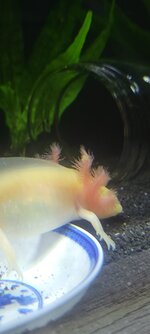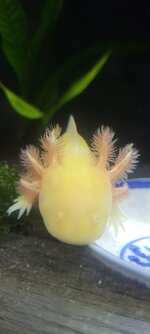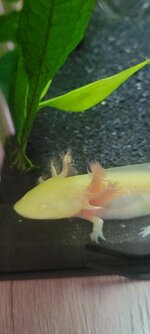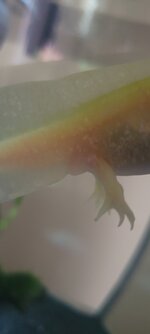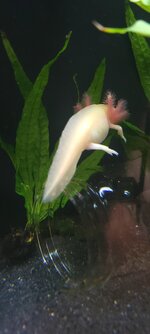Izcx
New member
Hello everyone,
I apologize for any formatting errors as I'm a first-time poster and writing this from a phone.
I began noticing a bit of discoloration developing on my axolotl's gills over the last week or so. Truthfully speaking, we've only had it (gender unknown) for a month. When we brought it home, it's gills were in a pretty pathetic state, and have been recovering and filling out like crazy. Im a bit of a worry wort and can't tell if these are iridophores, an environmental injury, or the beginning stages of a calumnaris outbreak.
Jörmungandr's water parameters are 7.8 pH, 0 ppm ammonia, 0 ppm nitrites, 10-20 ppm nitrates. Gh/kh are currently unknown, but the test kit is arriving later today and I would be more than happy to report back with the results if that information would be helpful in an armchair diagnosis. We also have a chiller, so the water temperature is a consistant 64-65 f.
As far as personality goes, nothing out of the ordinary to report that I can think of. It has an extremely healthy appetite, so no worries in that department.
Throwing in a cloaca shot in hopes that someone can tell me what gender lotl I have lol.
Thank you in advance, and sorry again for the formatting/photo quality!
I apologize for any formatting errors as I'm a first-time poster and writing this from a phone.
I began noticing a bit of discoloration developing on my axolotl's gills over the last week or so. Truthfully speaking, we've only had it (gender unknown) for a month. When we brought it home, it's gills were in a pretty pathetic state, and have been recovering and filling out like crazy. Im a bit of a worry wort and can't tell if these are iridophores, an environmental injury, or the beginning stages of a calumnaris outbreak.
Jörmungandr's water parameters are 7.8 pH, 0 ppm ammonia, 0 ppm nitrites, 10-20 ppm nitrates. Gh/kh are currently unknown, but the test kit is arriving later today and I would be more than happy to report back with the results if that information would be helpful in an armchair diagnosis. We also have a chiller, so the water temperature is a consistant 64-65 f.
As far as personality goes, nothing out of the ordinary to report that I can think of. It has an extremely healthy appetite, so no worries in that department.
Throwing in a cloaca shot in hopes that someone can tell me what gender lotl I have lol.
Thank you in advance, and sorry again for the formatting/photo quality!

